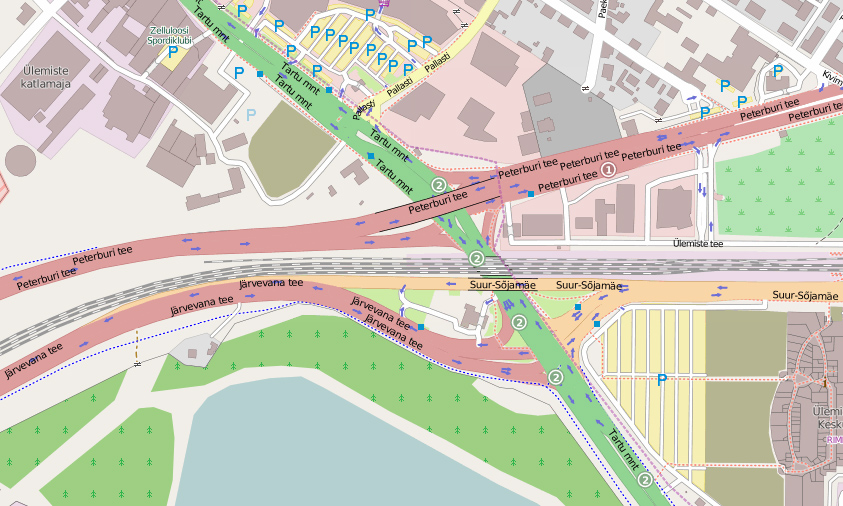Estonian most important crossroad in Ülemiste
Sieben Millionen Einwohner zählen die baltischen Staaten. Estland 1,3 Mio, Lettland 2,2 Mio und Litauen 3,5 Mio. Ihr BIP/Kopf der Bevölkerung reichte 2013 laut World Economic Outlook (April 2014) von 15’200 bis 19'000 Dollar (z. Vgl. CH: 81'300 $), wobei sich diese Zahlen Jahr für Jahr markant erhöhen. Seit 10 Jahren gehören die drei Länder zur EU. Estland und Lettland haben den Euro bereits eingeführt, Litauen soll 2015 folgen. Ihre Volkswirtschaften sind stark auf den Westen ausgerichtet und befinden sich in einem kontinuierlichen Wandel zu modernen Wirtschaften. Schweizer Unternehmen – auch KMU – können von einer Zusammenarbeit in vieler Hinsicht profitieren. Mit diesem Beitrag eröffnet o-mag eine neue Rubrik, in der sie verschiedene Branchen und Entwicklungen des Baltikums ausleuchtet. Die Beiträge erscheinen in deutscher und in englischer Sprache. Looking at the road map of Estonia, you will find the three most important roads of the country: Tallinn-Pärnu, Tallinn-Narva and Tallinn-Tartu. They all meet in the crossing near Tallinn city center at Ülemiste. It is one of the busiest road crossing in Estonia and many people stayed in traffic jams at rush hour at morning, when people came to work from suburban and bordering satellite cities, and in the evenings, when they leave their offices to drive home.
So, there was urgent need to build modern, multi-level crossing between these most important Estonian roads. These are Tallinn-Narva direction – called Peterburi road, Tallinn-Tartu (Tartu road) and Tallinn-Pärnu (Pärnu road) or internationally called Via Baltica, transit route that connects all Baltic countries to Central Europe. In Soviet time, there were some roundabouts and railway tunnel, what was sufficent for lower traffic. In the 1990ies these roundabouts were built over to traffic lights operated crossings. So, there were plans to connect Peterburi road directly to Järvevana tee, a connection to Via Baltica. And there were two options: to build a (probably most expensive) bridge over Tallinn – St. Peterburg railway or to dig a tunnel to cross it. Estonian most difficult road tunnelThe underground solution was cheaper than the bridge, but it concluded another obstacles. The soil of the shores of Ülemiste lake, which lies 500 meters from this crossing, was good for building works, because it consists mainly of pure sand. But the lake itself was a problem: the tunnel had to go about 7-16 meters below the lake water level and below the undeground waterfront. So the building had to be watertight. A second problem was, that the building had to be provided under an active railway, that had to be operated all time during the building process.
The reconstruction project of the traffic junction and the tunnel was made by Estonian company K-Projekt. They also had to resolve the water flow problem: underground waterfront moved from lake towards the sea and the tunnel crossed this water movement. So water pressure was from lakeside to tunnel wall. And there was another problem, also with tunnel in sandy soil: water pressure upwards, while the watertight tunnel is surrounded by water. So it had to be fixed somehow to the ground to stop moving upwards. To reduct the water pressure calculations showed that a draining layer with a thickness of about 0,5 meter would reduce the pressure of water from one side. But what about water pushing the tunnel up like a boat? This problem was sold by a wide bottom plate of the tunnel – much wider than the tunnel itself. This plate uses the weight of surrounding ground to make construction heavier, and in the ends deep anchors were used to prevent the tunnel construction move upwards. Rainwater for historic channelsThe groundwater and the rainwater had to be pumped out somewhere. The easiest solution was of course to connect the pump system with the local rainwater pipes. But they had a better idea. The Kadrioru park, the biggest park in Tallinn, had an old channel system, which was for more than a century practically ruined and abanduned for a long time. So, it was a good opportunity to pump the cleaned rainwater to the newly renovated channels of Kadriorg park. This channel system is part of old Russian czars residence – Kadriorg Castle and park. By renovating these channels, the water problem of Ülemiste crossing found a good and useful solution. The Channels end in the sea. Longest tunnel under the busiest railwayRight over the Ülemiste traffic junctions runs Tallinn-Peterburi and Tallinn-Tartu railway. It is the most important passenger railway direction and a very important transit railway for the country. It was impossible to interrupt any transportation of passengers and goods during the building time. Therefore a temporary railway of 800 meters was built next to the existing one. The challange: right alongside the temporary railway there were very deep excavation works. The level difference between the railway and the lowest tunnel level were some 11 meters. Steel sheet piling were used to avoid any soil movement, and needle filters to move water away. Separate tunnels were built with two lines each for both directions. The whole length of the tunnel is 680 meters, including 320 meters of covered section of tunnel. The tunnel is 9 meters wide and 6,3 meters tall, the walls are 0,6 meters thick and the ceiling panel is 0,7 meters thick. Important role for the futureIn the future Ülemiste crossing will become more important not only for Estonia, but for this part of Europe. Estonian’s leading crossing will be part of the transportation hub of Rail Baltic, soon to be projected as a speed railway system that connects Baltic countries to Central Europe. A Railway station is planned at Ülemiste, which will be connected by tram to the city centre and to the Tallinn Lennart Meri Airport, which is only a few kilometer away. The whole reconstruction project of Ülemiste crossing included the widening of Peterburi road, the viaduct over Tartu road, a new road from Peterburi tee to Filtri street, a tunnel under the railway from Filtri tee to Järvevana tee and the widening of Järvevana road. The Works started at summer 2010 and included 13 km new roads, 10 km light traffic roads, 2 traffic tunnels and 3 pedestrian/light traffic tunnels, one viaduct and 2 railway viaducts, landscaped 14 hectares of land, 16,5 km different sewerage pipelines and channels. The costs of this road-building project amounted to 70 million euros, covered in the amount of 75% from funds of European Union and another 25% by Tallinn city. Crossing and tunnel was opened in october 2013. The project was was selected as „Concrete Building of the Year 2013“ by Estonian Concrete Society. 1/3 better performanceAccordig to traffic survey, Ülemiste crossing becomes 1/3 more efficient; the big traffic jams are almost history for now. Only traffic accidents or bad weather conditions may influence this junction´s throughput. Before the reconstructions 1246 vehicles could pass per hour, after opening the new viaduct and tunnel the number increases to more than 3200 at morning rush hours 7-9 a.m.
See the project 3D rendering here
28.07.2014 | Autor
Kaido Einama
-> Drucken
|
MEHR ZU DIESEM THEMA
TOP ARTIKEL
TOP AKTUELLsoeben aufgeschaltet
MEIST GELESEN
|
||||||||||||||||||||||||||||||||||||||||||||
|
|
|||||||||||||||||||||||||||||||||||||||||||||
|
|
|||||||||||||||||||||||||||||||||||||||||||||






